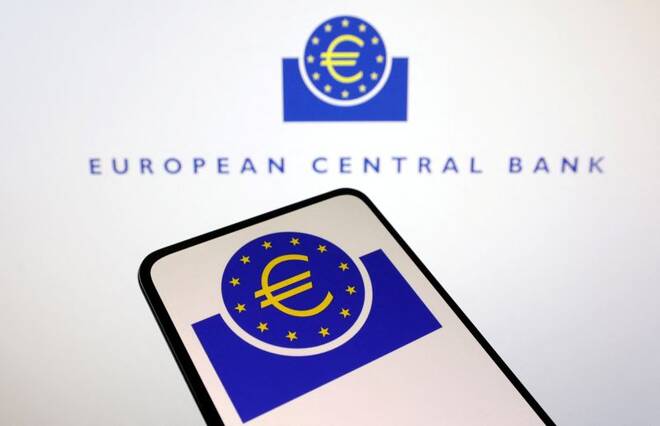Advertisement
Advertisement
How high will you go? Five questions for the ECB
By:
By Dhara Ranasinghe and Stefano Rebaudo LONDON (Reuters) - The European Central Bank looks set to deliver another hefty interest rate hike on Thursday, putting the market focus onto how far it is willing to go to fight inflation.
By Dhara Ranasinghe and Stefano Rebaudo
LONDON (Reuters) – The European Central Bank looks set to deliver another interest rate hike on Thursday, but turmoil in global bank stocks makes the outlook suddenly uncertain.
A surprise surge in underlying inflation in February had left policymakers fretting that price pressures could prove persistent.
Now, confidence in a large 50 basis point (bps) hike has weakened as turmoil in the U.S. banking sector raises fears about contagion in Europe.
The ECB has already tightened monetary policy by 3 percentage points since July.
Here are five questions for markets.
1/ What will the ECB do?
ECB President Christine Lagarde said recently a 50 basis points (bps) rate hike “is very, very likely”.
Yet traders cut their bets on such a move to around a 40% chance on Monday. It was almost fully priced in ahead of the collapses of Silicon Valley Bank and Signature Bank.
The ECB may be inclined to sound less hawkish in the face of renewed market turmoil, analysts said.
“I think the (ECB) communication on Thursday is still going to be for a 50 basis point rate hike, the underlying inflation problem is still there,” said Danske Bank chief analyst Piet Christiansen.
“But I think there’s going to be much more emphasis on the outlook from Lagarde on Thursday than if SVB hadn’t happened.”
(Graphic: The race to raise rates – https://www.reuters.com/graphics/GLOBAL-MARKETS/klvygnlbyvg/chart.png_
2/ What happens after March?
Markets have also dialled back expectations for May. Traders have now slashed bets on a 50 bps ECB hike in May they previously saw as highly likely, so signalling is key.
It could pre-commit to another big hike, stress a meeting-by-meeting approach, or flag several smaller increases.
Hawks have urged bigger moves. Austria’s central bank chief Robert Holzmann wants half-point moves at each of the next four meetings. Chief economist Philip Lane says “calibration” of further increases depends on new forecasts and data.
The ECB is meanwhile expected to stick to plans for shrinking its balance sheet by 15 billion euros ($15.89 billion) a month through June.
The banking sector turbulence was seen strengthening the case for a meeting-by-meeting approach.

3/ Where will rates peak?
Just a week ago market pricing suggested rates could rise to 4% by the end of the year. U.S. rate rise expectations also shot up. But that has been rapidly dialled back following the SVB collapse and money markets now see ECB rates peaking below 3.5% this year.
Germany’s two-year bond yield, which rose above 3% in late February for the first time since 2008, has also fallen back sharply..
“They (central banks) have to tackle their core mandate of getting inflation under control, they need to protect their credibility and keep signalling tightening policy but they do need to acknowledge signs of strain in some parts of the financial system,” said Guy Miller, chief market strategist at Zurich Insurance Group.

4/ Does the ECB think inflation is stuck?
Inflation, stripping out volatile food, energy, alcohol and tobacco prices, touched a record 5.6% last month and some policymakers fear that the increase is the result of a surge in wages in the services sector, which makes price growth harder to break.
Lagarde believes underlying inflation will stay high near-term and could be pressed on that time horizon.
Analysts say the cumulative impact of rate hikes has yet to be felt and will help to lower inflation.

5/ What about latest ECB economic projections?
Signs of economic resilience suggest ECB growth forecasts, also out on Thursday, could be revised upwards for 2023. Euro area business activity growth was at a nine-month high in February.
Falling energy prices and a stronger euro, up around 6% in trade-weighted terms from August lows, suggest headline inflation forecasts could be revised lower.
Strong underlying price pressures mean longer-term forecasts will be watched closely.
“In their forecasts, headline inflation should be lower, as energy prices fall, but core inflation is staying very stubbornly high,” Eoin Walsh, portfolio manager at TwentyFour Asset Management, said, adding: “They will certainly be careful not to sound too dovish.”

($1 = 0.9442 euros)
(Reporting by Dhara Ranasinghe in London and Stefano Rebaudo in Milan additional reporting by Yoruk Bahceli; Graphics by Sumanta Sen, Kripa Jayaram, Riddhima Talwani; editing Barbara Lewis and Sharon Singleton)
About the Author
Reuterscontributor
Reuters, the news and media division of Thomson Reuters, is the world’s largest international multimedia news provider reaching more than one billion people every day. Reuters provides trusted business, financial, national, and international news to professionals via Thomson Reuters desktops, the world's media organizations, and directly to consumers at Reuters.com and via Reuters TV. Learn more about Thomson Reuters products:
Did you find this article useful?
Latest news and analysis
Advertisement
